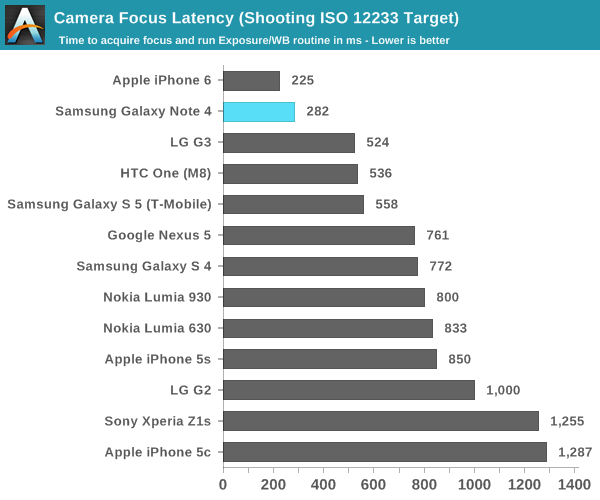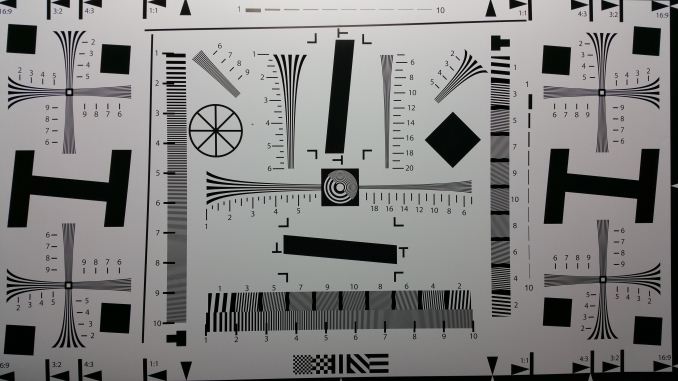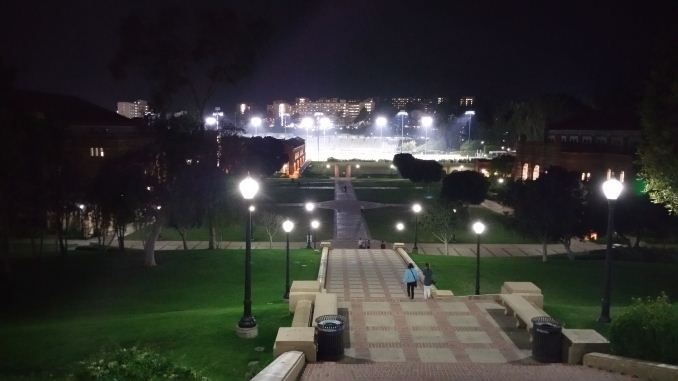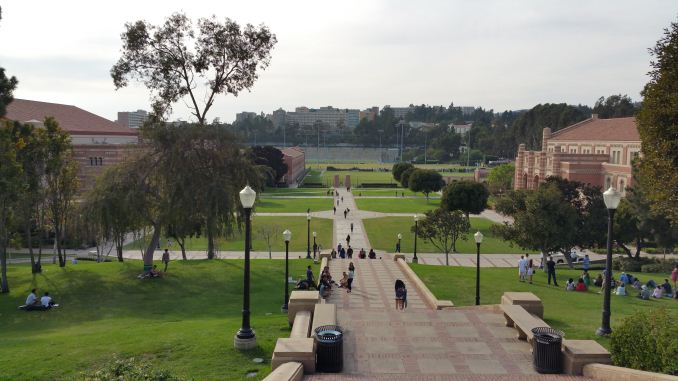The Samsung Galaxy Note 4 Review
by Joshua Ho on October 15, 2014 9:00 AM EST- Posted in
- Smartphones
- Samsung
- Android
- Mobile
- Galaxy Note 4
Camera
While the 16MP camera of the Galaxy Note 4 is mostly what we would expect, Samsung has really changed things up with the addition of OIS. Outside of this addition and the Sony IMX240 sensor, there’s really not a lot of change when it comes to the Galaxy Note 4. This means that we see the same 31mm equivalent focal length and F/2.27 aperture. At this point, it seems that OIS has finally reached mainstream adoption as both Samsung and Apple are shipping OIS solutions on their phones. The front facing camera is noticeably different though, with a Samsung S5K6D1YX sensor that I haven't seen elsewhere.
However, before we get into the proper image quality analysis I wanted to first cover shot to shot latency and focus/AE latency, as both are critical to a good image capture experience. Even if it’s possible to get amazing photos from a camera, it doesn’t really matter if the moment is missed. In order to test this, we look at the ideal case, which is when the phone is pointed at the ISO chart with bright lighting to maximize contrast.


As one can see in the graphs above, capture latency and focus latency are quite competitive with on the Note 4. However, there is one crucial detail that the focus latency graph misses, which is that Samsung doesn’t have continuous auto-focus in preview with the Note 4. As a result, there’s realistically an additional latency period before the auto-focus begins to run. The result is that the total time from out of focus to in focus is realistically closer to 800ms, but if one immediately taps the display to begin an AF run it’s possible to achieve the lower bound value, which is just south of 300ms.
Still Image Performance
While I'm still working on moving towards a better test for cameras, for now we have our standard photo comparisons that should give a good idea of what to expect from a smartphone camera in comparison to other cameras. Our first test is the standard ISO chart, which allows for a good test of maximum resolution.

For this first test, it seems that Samsung hasn't really changed much when it comes to maximum resolution, and in general the Note 4 produces similar output to the Galaxy S5. To verify this and a test of dynamic range, we'll look at a landscape shot next.
In this test, we see that the Galaxy Note 4 generally does well with detail and dynamic range as the landscape is generally well-detailed, although there's quite a bit of detail that seems to be smudged away on the grass as it seems to be a flat green texture for the most part. There's also noticeable color artifacting on the bleachers in the distance. We'll look at the same scene in low light to get a better idea for what the Note 4 really brings to the table.
Here, in low light we see significant improvements in image quality when comparing the Galaxy S5 to the Galaxy Note 4. The iPhone 6 Plus and Note 4 are quite close in overal quality, but looking at the brick building on the right of the image shows that the iPhone 6 Plus is maintaining a higher level of detail in this scene.
In the case of HDR, Samsung continues to do a great job with their implementation. For the most part this feature is successfully implemented with no real halos or other artifacts even when there are moving objects in the shot. This is likely to be implemented through on-sensor HDR rather than image combination.





































195 Comments
View All Comments
xype - Thursday, October 16, 2014 - link
Uh, huh, haha, you are teh funnay.It _is_ ugly, actually. Plenty of better looking Android devices out there. I don’t know why tech writers need to even add stuff like "design massively improved", when it’s actually not _massively_ improved.
And, no, I don’t think the iPhone 6 is massively improved design-wise (though it looks better from the front than anything Samsung offers), either.
And design is not subjective and open to interpretation. If it was, people wouldn’t be able to agree on a "best design", ever, because the type of looks people liked would be evenly divided among all kinds of designs. And there would be no rules on how to make things look good, either. Just because companies like Samsung don’t understand them it doesn’t mean that those don’t exist.
Tams80 - Thursday, October 16, 2014 - link
People don't agree on 'best design ever'. Well a small group of self congratulatory can, but such a group have often lost touch with reality.theduckofdeath - Thursday, October 16, 2014 - link
You're shooting yourself in the foot if you're arguing that design is not subjective, as Samsung sell 300 million smartphones every year, all of them tends to follow the design language of their current flagship device. So....?tralalalalalala40 - Friday, October 17, 2014 - link
They are giving phones away. Consumers like that, and Samsung is only helping google ironically. Seen their profit's this quarter?solipsism - Wednesday, October 15, 2014 - link
So the Note 4 is thicker, header, only a 32GB only, and USB 3.0 replaced with USB 2.0 over the Note 3? Am I reading that properly?theduckofdeath - Wednesday, October 15, 2014 - link
Probably not, because we don't know what you mean by header. :DThe phone will also come with 64GB storage and it supports SD storage at 128GB and 256GB when that size is in the stores.
The shift back to USB 2 is probably a pretty smart one, as the larger USB 3 connector isn't very convenient.
melgross - Wednesday, October 15, 2014 - link
Using the USB 3 connector wouldn't allow you to make phone calls, among other problems. They had to get rid of it. I can't understand why testing didn't show that.NZtechfreak - Saturday, October 18, 2014 - link
I didn't wait for 256gb micro SD, using a full size 256gb SD in my Note 3 (modified wooden case and ribbon adapter). So, if you must have that right now you can. I'm mulling over whether to get the 512gb SD card and stay with my Note 3 until my contact renews and then grab a Note 4 or something else...rpg1966 - Wednesday, October 15, 2014 - link
"...every GPS fix is a hot fix and takes around 5 seconds" and "...I saw that it took around 50 seconds to achieve a lock".I'm sure I'm being a bit thick, but what does this mean? The initial lock is ~50s, then ~5s thereafter?
JoshHo - Wednesday, October 15, 2014 - link
The initial lock is 50s only if you deliberately clear assistance data (or it expires after a few days of non-use) with airplane mode on. Otherwise it should be less than 10-15 seconds.